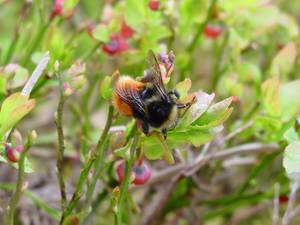The venom found in bee stings could be used as targeted therapy against cancer, according to a report in the Journal of Clinical Investigation.
 By attaching the venom protein, melittin, to tiny, spherical 'nano-bees', and injecting them into mice suffering with cancer, researchers at Washington university saw tumours either stop growing, or actually shrink. Melittin is a small protein, and works by attaching to the cell membrane and forming pores in the cell, and it's thought that tumours will not be able to develop resistance against this form of attack.
By attaching the venom protein, melittin, to tiny, spherical 'nano-bees', and injecting them into mice suffering with cancer, researchers at Washington university saw tumours either stop growing, or actually shrink. Melittin is a small protein, and works by attaching to the cell membrane and forming pores in the cell, and it's thought that tumours will not be able to develop resistance against this form of attack.
Tumours are known to concentrate certain materials, due to an effect called enhanced permeability and retention which occurs because solid tumours often have leaky blood vessels. This means the nano-bees will build up in the tumour tissue, targeting the cancer directly. Adding extra targeting agents, which are attracted to developing blood vessels, further increases the nano-bees affinity for tumours, and reduced the proliferation of precancerous skin cells by 80 percent in mice.
Melittin is usually broken down by normal biological processes, but by packaging the protein with the nano-bees, it was both protected and kept away from healthy tissue. The core of the nano-bees themselves are made of a chemical called perfluorocarbon, an inert compound used in artificial blood. Each one is about six millionths of an inch in diameter, which is small enough to travel through the bloodstream and attach to the desired cell membranes, but large enough to carry thousands of active compounds.
The nanobees have been tested against two different kinds of cancerous tumours in mouse models; breast cancer cells and melanoma tumours. After the nanobees were introduced, growth of the breast cancer tumours slowed by nearly 25 percent, and the size of the mice's melanoma tumours decreased by 88 percent relative to untreated tumours.
According to Samuel Wickline, 'Melittin is a workhorse, it's very stable on the nanoparticles, and it's easily and cheaply produced." This shows great promise, but it is early days yet, and we don't yet know if it will prove to be a viable clinical application. However, every method we find that can help treat cancer adds to our arsenal, and this one really does have a sting in it's tail.










Comments
Add a comment